Vertical heating radiators - a combination of beauty and
The only thing that distinguishes vertical radiators from conventional radiators is their size. The height is several times the width - hence the name. Such a change in the geometry of the device slightly affects the efficiency, it can be called a price for an unusual appearance and versatility during installation.
Given the popularity of these devices, it makes sense to consider in more detail their types, installation methods and technical specifications.
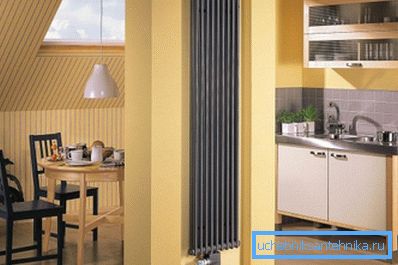
History of vertical radiators
From a technical point of view, vertical water radiators do not make sense - there is no gain in heating efficiency, production, and, accordingly, the cost does not decrease.
The main reason for the appearance of this type of battery is due to the geometry of the premises. Heating radiators, which are familiar to everyone, are usually placed in the niches under the windows, vertical devices are more universal in this regard, they can be placed, for example, along a wall in a corner of the room, closer to the riser.
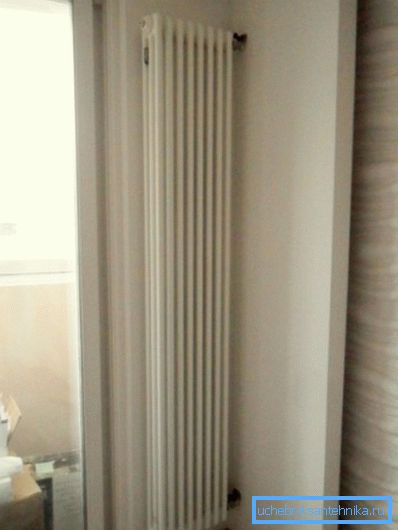
The specific date of the first vertical battery can not be named, but it is not so important. The main thing is that such a device allows the most efficient use of space near the walls of the room.
More on vertical batteries
The beauty of choosing batteries for the home, of course, plays an important role, but the main parameters are still considered heat transfer, cost and ease of installation, because often the installation is done by hand. Therefore, it is worthwhile to take a closer look at the technical characteristics, operating experience and efficiency of such devices.
Advantages and disadvantages
First, the advantages of an elongated battery:
- this allows them to be installed almost anywhere in the room.. For example, a narrow section of the wall between the window and the wall is suitable, and due to its proximity to the riser, fewer pipes will be required for wiring;
- manufacturers, realizing the advantages of this form, pay special attention to the appearance. If the budget allows, you can buy a battery that will become a real decoration of any room;

- with a shortage of free space, they will help save usable space.
Note! It should be understood that with equal area, the vertical radiator is somewhat inferior to the traditional radiator.
As for the shortcomings, there are not so many of them:
- cost - the price of such devices is significantly higher than conventional batteries;
- the upper part of the radiator will work less efficiently than the lower, because warm air will accumulate under the ceiling, which means the temperature difference between the metal surface and the air will be less;
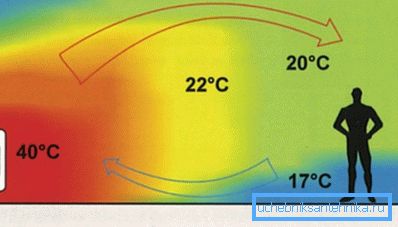
- heating the room will be uneven. In small rooms, this is not so noticeable, but in large rooms, an increase in the number of radiators may be needed to eliminate discomfort, which will increase the cost of heating.
Classification
As for materials, vertical heating radiators are made of the same materials as conventional batteries. That is, the choice is between a cast-iron, aluminum, steel or bimetallic device.
As for the appearance, we can distinguish:
- conventional sectional design - the device is no different from conventional batteries, except for the size;
- pipe - outwardly look like a simple register, for a more spectacular appearance of the pipe often bend and fancy designs are formed from them;

- Mirror radiators are suitable for high-tech interior design - in them a pipe with heat carrier and fins is closed with a solid mirror panel;
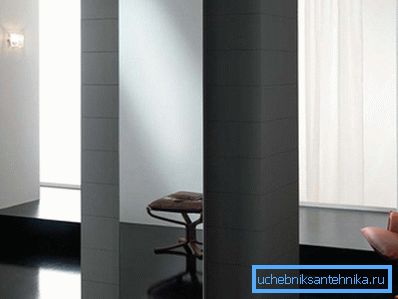
- Radiators stand out in isolation, in which the attention is paid to appearance.
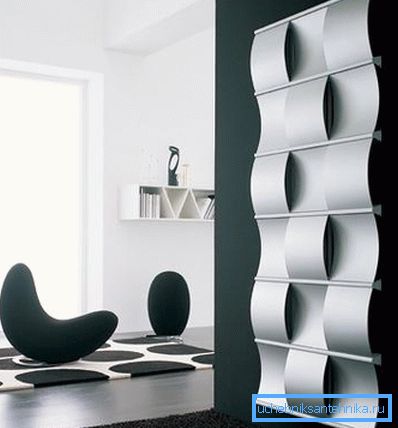
They can also be classified according to the connection method - side or bottom and in depth.
You can highlight:
- thin models (thickness is about 4-5 cm);
- average - about 6 cm;
- deep - about 10 cm;
- very deep - over 12 cm.
Installation details
In general, the installation process remains unchanged.
The instruction in general looks like this:
- markings are made, mounts are arranged in the wall;
Note! As a rule, vertical batteries are quite heavy devices, therefore it is recommended to fasten them to the bearing walls. The thin partition can simply not withstand.
- the radiator is mounted on the mount;
- it is connected to the heating system;

Note! In the upper part, it is necessary to install a Mayevsky crane, it will be needed to combat air traffic jams.
- check the tightness of the connection.
If, in the case of conventional radiators, a diagonal connection is considered optimal, then for vertical counterparts, the lower connection option for the supply pipe and return pipe is considered best. Of course, you can lift the supply pipe to the top of the device, but the pipe is unlikely to look at the background of the wall. Another advantage of the lower connection can be considered the ability to hide pipes under the floor.
Overview of several popular manufacturers
Over the years of operation, several companies have recommended themselves well:
- Kermi - German manufacturer, produces radiators with dimensions of 600 - 2800 mm in height (200 mm pitch) and a length of 350 - 1330 mm (70 mm pitch). As for the depth, the vertical radiator is available in 4 sizes - 43, 61, 104 and 122 mm;
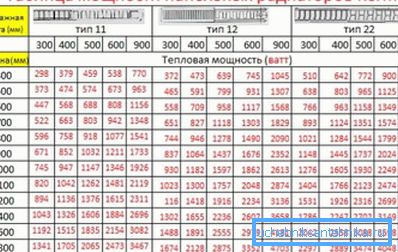
- Arbonia - manufacturer from Switzerland, products can be attributed to the upper price segment. It also produces sectional tubular radiators of heating. Model sizes are 190 - 3000 mm (height), length is measured in sections - from 4 to 60, width of one section is 45 mm. From other competitors, the products of this manufacturer are distinguished by the presence of models of angular and radial formats.
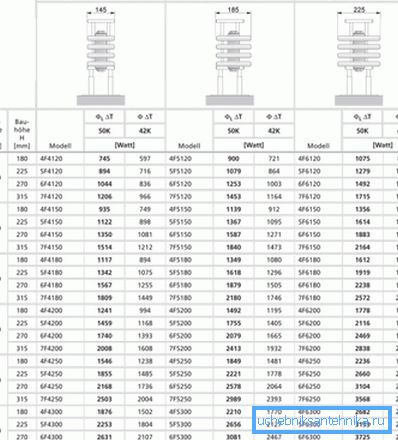
- Purmo Delta Laserline - The birthplace of this company is Finland. In terms of price / quality / heating efficiency, radiators from this manufacturer can be considered among the best. The height of the battery is in the range of 300 - 3000 mm, and for 1 section will have to pay from 600 rubles.

- Zehnder - Another representative of Germany. Produces quite powerful radiators, they are suitable for heating large rooms. The dimensions of the devices are: depth - 62 - 210 mm, height - 200 - 6000 mm. The cost of the section is only slightly higher than that of Purmo Delta - about 750-800 rubles per section.
Summarizing
Vertical radiators are not much in terms of efficiency, but still inferior to conventional batteries, and their cost cannot be called democratic. However, such devices are popular, because they practically have no installation restrictions and allow you to efficiently use the free space in the room (see also the article What are Kermi steel radiators and how they are used).
A slight drop in efficiency can be compensated by increasing the area of the radiator itself. The video shows various options for vertical radiators.